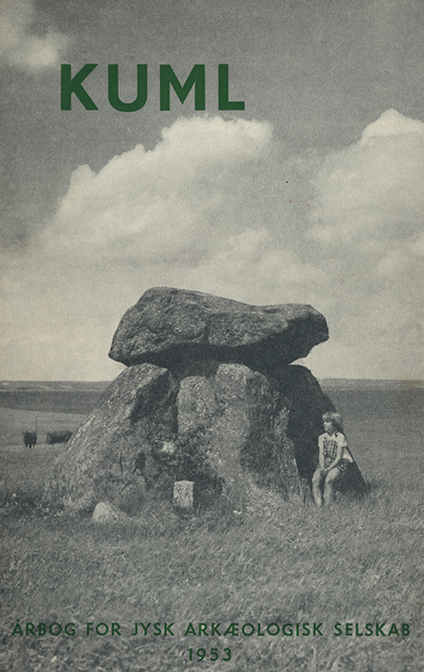To djurslandske mosefund
DOI:
https://doi.org/10.7146/kuml.v3i3.97109Nøgleord:
Painted pottery, Malet keramik, Albøge, Torsager, Celtic Iron Age, Keltisk jernalderResumé
Two Peat-finds from Djursland.
Between 1940 and 1947 large quantities of pottery, mainly from the New Stone Age and from the Early Iron Age, were found in Danish peat bogs. Djursland, in Jutland, is one of the areas from which particularly rich hauls reached the National Museum, and two of these discoveries, from the Celtic Iron Age, are here described.
Torsager Dairy: 600 metres east of Torsager Church. Here numerous prehistoric objects were found at a depth of about one metre, over a stretch of 400 metres about 20-40 metres from the shore of the peat bog). The skull of a woman, aged about 40-50, lay in the peat, without jawbone or any other part of the skeleton. Of ten bones of horses found, seven were pelvic bones, lying together in a heap. Three pieces of broken wooden tools were found, and in addition well over 100 whole or fragmentary pottery vessels, of which 19 have been preserved. They were without doubt all unbroken when they were deposited in the bog. The rim sections are rounded, thickened or straight cut, the handles ribbon-shaped and the bases broad and flat or else ring-bases, while ornamentation consisted of an offset shoulder or of one or two lines running round the shoulder (figs. 1-2). Comparison with Becker's material from Trelleborg) and with the pottery discovered in the lower level of the Borremose moat shows clearly that the greater part belongs to the Northeast Jutland cultural group in Becker's Period II. This is a clear case of offerings in a sacred peat bog, and as Torsager has always been a religious centre in Christian times and, to judge by the name, was also of cult importance before Christendom, this discovery can be equated with the sacrificial deposits from Vimose and Torsbjerg, both also places where the names suggest a heathen cult centre.
Albøge Peat Bog: a little east of Albøge town. Here, in a packet of peat only 70 metres across containing a 4 metre thick peat layer, a large number of prehistoric objects vere found). Apart from a Stone Age pottery vessel and a wooden cart axle, which lay deeper, all the objects were found a half to one metre below the surface, at a height of about two metres above the bed of the bog. 6 pottery vessels, 15 bones of mammals, one hammer stone and 5 fragments of flint axes were found scattered individually. In addition there were found about 80-85 pottery vessels, almost all in small fragments, an iron sword and a pottery spindle-whorl. All these lay in 23 heaps of sherds, each about three-quarters of a metre in diameter and consisting of sherds from a large number of vessels, sherds of normally fired, underfired and overfired vessels being found mixed up with lumps of raw clay. The largest heap contained 672 sherds. The spindle-whorl, which lay in the bottom of a vessel, had been made from a sherd. The sword was of typical La Tene type, with a tang and sloping shoulders. Among the pottery material (figs. 3-4) occurred rims of round, thickened, straightcut and fluted types; handles were ribbon-shaped, fluted or X-shaped, a ring-base occurred once, and ornamentation was uncommon. Parallels can be found at Trelleborg), in the upper layer of the Borremose moat and at Kraghede). This pottery also belongs to the Northeast Jutland group within the Late Celtic Iron Age, but while three of the individually found vessels and five of the heaps of sherds belong to Becker's Period II two of the sherd heaps must be ascribed to Period III and seven to the transitional stage II/III or to Period III. The present writer interprets this discovery as rubbish discarded from pottery manufacture, each heap representing a single clearing up of a workshop. This, therefore, in contrast to the Torsager discovery, must be considered a completely secular deposit.
Painted pottery: is very rare in Denmark. To date eight painted vessels are known from the Early Roman Iron Age, from Vendsyssel and South Jutland), and one vessel from the Late Celtic Period, from Bukkerup peat bog on Funen. In the Albøge discovery there were eleven painted sherds and in the Torsager discovery one (fig. 5). Including these discoveries the use of black paint is known from the Celtic Iron Age and of gray and white paint from the Roman Period. The following patterns occur: dots, centre-pointed circles, zigzags, triangles, "crescent-friezes" and vertical and horizontal stripes. As these are the same patterns as are used in incised ornamentation, and as the shapes of the vessels are local, we may conclude that a native school of pottery painting existed in the Early Iron Age, with its roots in Central Europe
Povl Simonsen
Downloads
Publiceret
Citation/Eksport
Nummer
Sektion
Licens
Fra og med årgang 2022 er artikler udgivet i Kuml med en licens fra Creative Commons (CC BY-NC-SA 4.0).
Alle tidligere årgange af tidsskriftet er ikke udgivet med en licens fra Creative Commons.


